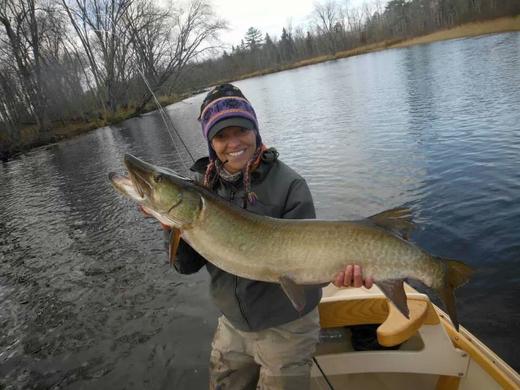
Wendy Williamson, From Trout to Musky: The Story of a Life and Evolution in Fly Fishing

This spring, the Midwestern fly fishing community was unable to gather for the Great Waters Fly Fishing Expo because of COVID-19. Fishe was also hoping to be there and to connect with a profoundly deep pool of Midwestern women who love to fish. This month, we’re profiling Midwestern bass and musky guide and fly shop owner Wendy Williamson about her life and work, as she shares some musky fishing tips for beginners.
When I think about the heroes of my fly-fishing universe, Wendy Williamson looms large. I met her at a women’s fly fishing clinic in Wisconsin in 2012. I was a beginner, and she was my “River Buddy,” tasked with taking me out to hunt trout for a few hours, showing me some skills, and making sure I didn’t get into too much trouble. At the time, I had no idea who Wendy was -- had no idea that she was an iconic Northern Wisconsin bass and musky guide in a male-dominated arena -- but it was evident even from my meagerly-informed perspective that she knew what she was doing. She was relaxed and carried herself with an easy confidence. Her generosity, energy, and joyful sense of humor were infectious, as was her love of all things fly fishing. We sat down on the side of the river to contemplate fly-selection, and I’ll never forget how I gasped when she opened her trout box – rows and rows of flies organized meticulously by size and pattern. No joke, it blew my mind. We fished all evening, and thinking back I now recognize the skills of a consummate professional. She knew how much leash to give me, how to let me explore on my own but also how to offer selective advice to help me move forward. By the end of the night she was teaching me how to double-haul, and I thought I just might be in love.
Over the years Wendy and I have been in and out of touch, and I realized that as much as I idolized her, I knew very little of her story. How did she learn to do what she did? How did she learn to fish for bass and musky? And what about that trout box? Where did that come from? I reached out to Wendy, and she generously agreed to spend some time talking with me about her life and her passion. Eight years later she has not lost one bit of her characteristic swagger, and she is still absolutely hilarious, but as I read between the lines of our conversation, what emerges for me is a narrative of a woman who is a pioneer in her sport, and who got to where she is today through a rare combination of compassion and cojones, grit and gratitude.
Wendy grew up in Hayward, Wisconsin, a town of around 2,300 people in the Northwestern corner of the state. The middle child of seven children, she spent her youth hunting and spin fishing with her brothers, but her path to being a fly fishing guide was roundabout. Not unlike many of us who find ourselves with a fly rod in our hands, I get the sense that for Wendy, fly fishing is something of a calling. “I had nobody in my family that fly fished,” says Wendy, “I was always enamored with it. I can remember watching Curt Gowdy on American Sportsman, and he’d be fly fishing someplace, and I’d be like ‘oh wow, what a cool thing!’” Wendy remembers finding an old bamboo fly rod at home that she thinks her father may have brought back from Japan during WWII. She took it out one day to experiment and found that she had a knack for it. She began catching bluegill and small pike. “I didn’t know what I was doing, but I was catching fish like crazy, you know?” While working as a dental assistant in her 20s and 30s, Wendy borrowed some fly fishing equipment from her boss. She started trout fishing and remembers catching her first trout pretty quickly, which she attributes solely to “dumb luck,” but it encouraged her to continue on in what would become “a long, long, long learning process.” She began taking trips out West to fish the Bighorn River in Montana, and this is where she really cut her chops, observing other fishermen, hanging out at fly shops, and learning by trial and error. “I remember that I kind of judged my progress by how many wind knots I would have, “ Wendy says, “and I vowed ‘If I get a wind knot, I’m gonna untie it until I figure out how I put it in there in the first place.’”
Wendy got her first opportunity to guide in 1995, when she was recruited to work at an upscale lodge in Meeker, Colorado. She moved out West and spent 10 years guiding the White River, eventually meeting and marrying her husband Larry Mann -- also a fishing guide. When asked about her entrée into guiding, Wendy chalks it up to good fortune: “the whole thing was timing. It was nothing but timing.” Dig deeper, and she talks about how the lodge was looking to recruit a female guide to round out their team, as many of the lodge guests were couples. At the time, Wendy was not aware that previous female guides at the lodge had all quit, after receiving a not-so-warm welcome from the male guide staff. I ask how she survived, and she responds with characteristic humor. “Having brothers, that helped!” -- that and knowing how to handle a shotgun. “I had my shotgun with me, and at one of the first gatherings they were throwing clay targets. I guess I did okay, and they kind of backed off a little bit.” Like I said, grit and cojones.
Wendy sees 1998 as a turning point in her life. It was the year after her father died and the year her sister called her up to let her know that their mother was struggling. Wendy and Larry decided to return to Hayward to spend a few months with Wendy’s family. They never returned to Colorado. In retrospect, says Wendy, it was the best thing that could have happened to them. Now newly rooted back in the Midwest, Wendy and Larry had to figure out how to remake their fishing careers in a very different landscape. Wendy says she thought back to her youth, to the folks who fished for musky and pike and bass on their local lakes, and she and Larry thought they would give it a shot. In the fisheries of her hometown, she learned to target new species that made her even more excited about fly fishing, and she found the professional fly fishing community in the Midwest to be more laid back and friendly than the Western fly shop scene. And so, paradoxically, in the midst of coming home during a family crisis, a whole new world opened up for them.

Photo courtesy of Wendy Williamson
Being a trout angler myself, I asked Wendy to speak a bit about what it was like to change gears from targeting relatively small, cold water fish in the Rockies to targeting big, Midwestern predators. Wendy talked about how it took a while and a bit of trial and error to figure out the watersheds that they now fish. She and Larry started by taking exploratory trips to the Boundary Waters of Minnesota to fish for bass, and they quickly began to discover how exciting warm water species could be. Wendy describes her thoughts at the time: “this is so much more fun than fishing for trout I can hardly stand it!” They also discovered that, while it is possible to fish for trout in Northern Wisconsin, their local waters did not remain cold enough to fish for trout safely during the summer. They decided to leave trout fishing behind and focus on guiding for bass and musky instead. At the time, Wendy says, most guides were taking clients to fish for musky in lakes, so Wendy and Larry decided to take a different approach. They spent a winter scouting local water and then started guiding for musky and bass in the nearby Namekagon, Chippewa, Flambeau, and St. Croix Rivers. “I did not want to guide on the lake, because growing up here I had a lot of friends whose fathers raised them by being a guide on the lake,” says Wendy. “I said, there’s no need to compete with the lake guys. Nobody’s doing this on the river, and we’re river people. Who knew that was gonna work out, and who knew we’d be at the front of that wave, of that warm water thing?”
Wendy says that she and Larry had a clear vision of how they wanted to guide and fish, and it is a vision that they follow to this day. “We kept it narrow,” she says --fishing from drift boats, using fly tackle, and fishing catch-and-release with single, barbless hooks. It was a relatively new approach in Hayward at that time, and one that caught on. Eventually they expanded their guide business, and in 2005 they opened up their own fly shop, Hayward Fly Fishing Company. “We never dreamed it would get this big,” Wendy muses. “When Larry and I started doing this there were no drift boats here, and we would go out, and there was nobody out there.” She remembers what it was like to see 150 drift boat trailers at boat ramps on the Bighorn, back in her trout days. And though she knows that Northern Wisconsin rivers still don’t get anywhere near this kind of traffic, she finds it remarkable how popular fly fishing has become in Hayward and how incredible their fisheries are. “I truly believe that the Midwest is perhaps the best place to be for fly fishermen, because there are so many opportunities. Some of our guide friends come here, and they’re just going ‘Oh my God I had no idea!’”
When I ask Wendy to tell me a bit more about fishing for musky and to give some context for those of us trout-heads who’d like to expand our horizons, she starts with the basics. Musky (Esox masquinongy) are related to northern pike (Esox Lucius) and have a similar appearance (long bodies) and behavior (predatory). The average-sized musky is about 36-inches long, but they can grow to be over 50-inches. Wendy says that in the area where she guides, musky “are the top freshwater predator.” “Their eyes are kind of focused forward, like a wolf, and they are bottom-up feeders,” scanning the water above them, and going into attack mode once they spot their prey. According to Wendy, a musky’s main diet consists mainly of small baitfish, like perch, but they will also eat frogs, crawfish, and some insects. On rare occasions a larger musky might eat a small duckling or rodent, but this is not the mainstay of their diet. I ask Wendy about where musky tend to hold in the river, and she says it depends on the season and conditions, but mostly she emphasizes their unpredictability. “It drives me crazy. People ask, ‘Is that musky water? Is that musky water?’ Any of it is. I have seen them come out of places where you think there should not be one, and then you’re going ‘well they gotta be here right?’ and it never happens. So they’re all over the place.”
We discuss how musky are notoriously difficult to catch, widely famed as “the fish of 10,000 casts,” and I admit to Wendy how doubtful I am of my own ability to tackle musky fishing. In true form, Wendy downplays the amount of skill needed to stalk these elusive predators and questions the “10,000 casts” label. While she acknowledges that “the more casts you put out the more chance you have of taking a musky,” she and Larry have discovered that fishing for musky in a river from a drift boat helps an angler to cover a lot more water and have more chances at fish. “It shouldn’t be intimidating, and it’s not rocket science either,” Wendy says encouragingly, addressing my insecurities. I am reminded of our trout fishing escapades eight years earlier, of that understated, good-natured, reassuring presence that somehow made me feel bigger than I was. And suddenly it occurs to me that even though Wendy’s path into fly fishing may have been circuitous, she has landed squarely where she belongs. Wendy Williamson was born to be a guide – in her heart and soul. She is an expert at intuiting what people need and using her own vast knowledge to quietly empower them.
As we finished up our interview -- and I started contemplating when I might be able to carve out time in my schedule to book a musky trip to Hayward -- I asked Wendy if she would give some pearls of wisdom to our readers who might want to branch out and try for a musky. She generously acquiesced with the following musky tips:
- Contrary to popular belief, you don’t have to throw a fly the size of a small mammal to catch a musky. A baitfish pattern in the 6-inch range will do. Muskies will take a variety of fly styles/colors. Wendy favors saltwater flies, like a Clouser jig or a Reducer, though she points out that there are a variety of saltwater baitfish patterns that will do the trick. Saltwater flies tend to be tied on stronger hooks that have wider hook-gaps, making a good hook-set more likely. However, Wendy says the most important question is “do you have faith in the fly?”
- Because you don’t need to fish a ginormous fly, you also don’t need to swing a big 10, 11, or 12-weight rod to catch a musky. An 8 or 9-weight rod will do. If you hook up a big fish, “engage the butt” of the rod to help give you more power when fighting it. According to Wendy, musky tend to sound down to the bottom of the river more than they run.
- If a musky takes your fly, don’t trout set, strip set! You will likely need to set the hook more than once, as the flies have so many fibers, and you want to be sure that the hook is actually in the jaw of the fish.
- Doing a typical “figure-8” (where you draw a figure-8 pattern with the tip of your rod in the water after stripping the fly in close to the boat -- a classic musky fishing technique) is not a must, and it can be downright difficult when fishing in rivers with significant current. What is most important is to “do something different with the fly” at the end of your strip. Change the speed or direction of the fly as you strip it in close, as muskies will often take flies right next to the boat.
- Muskies are sensitive to temperature, not unlike trout. Don’t fish for musky when the water temperature is in the mid-70s (Fahrenheit) or warmer. Though musky live in what we often think of as warm-water fisheries, they go to deep pools in the summer, and hooking one up in warm water temps could be fatal. Fish for musky in the spring and fall, when the water temps are cooler. Prime times are May/June and October/November.
Photo courtesy of Gini McCain
If Wendy’s enthusiasm and passion for fishing have you reaching for your 9-weight, think about taking a (socially distanced) road trip to Hayward to get your musky on! According to Wendy, the best times of the year to fish for musky in Hayward are the spring and the fall (see #5 on water temp, above). During the summer months, the Hayward bass fishery is also in full swing. Wendy and Hayward Fly Fishing Company welcome anglers of all skill levels. Note: like most responsible outfitters, Hayward Fly Fishing Company is taking all possible COVID-19 precautions, and both clients and guides are required to wear masks in the boat on guided trips. Please do not travel if you are sick or have been exposed to someone who is. For more information, visit the Hayward Fly Fishing Company website: www.haywardflyfishingcompany.

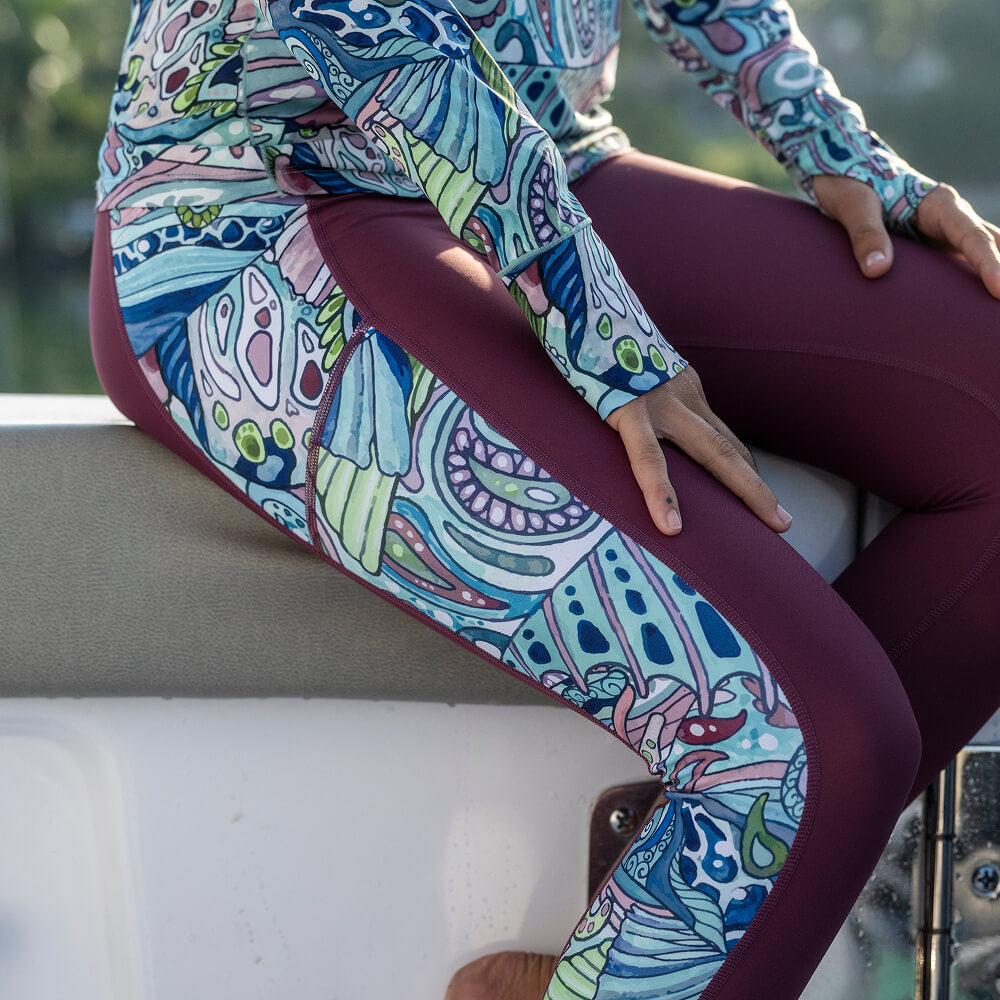

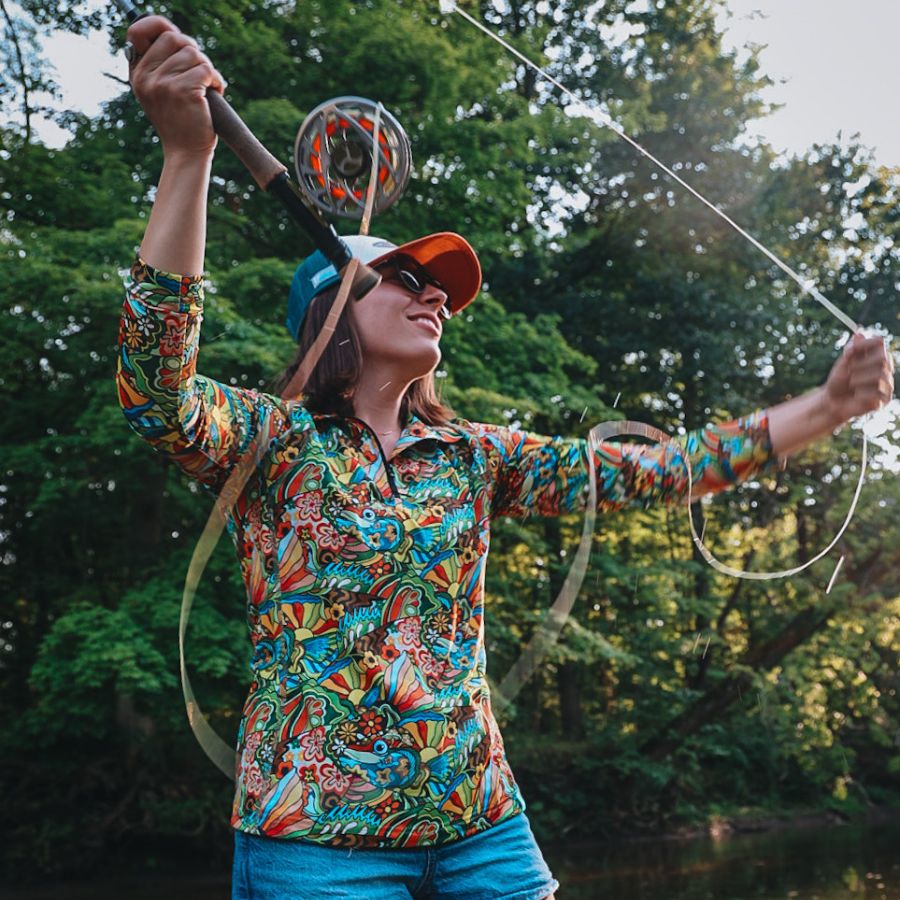

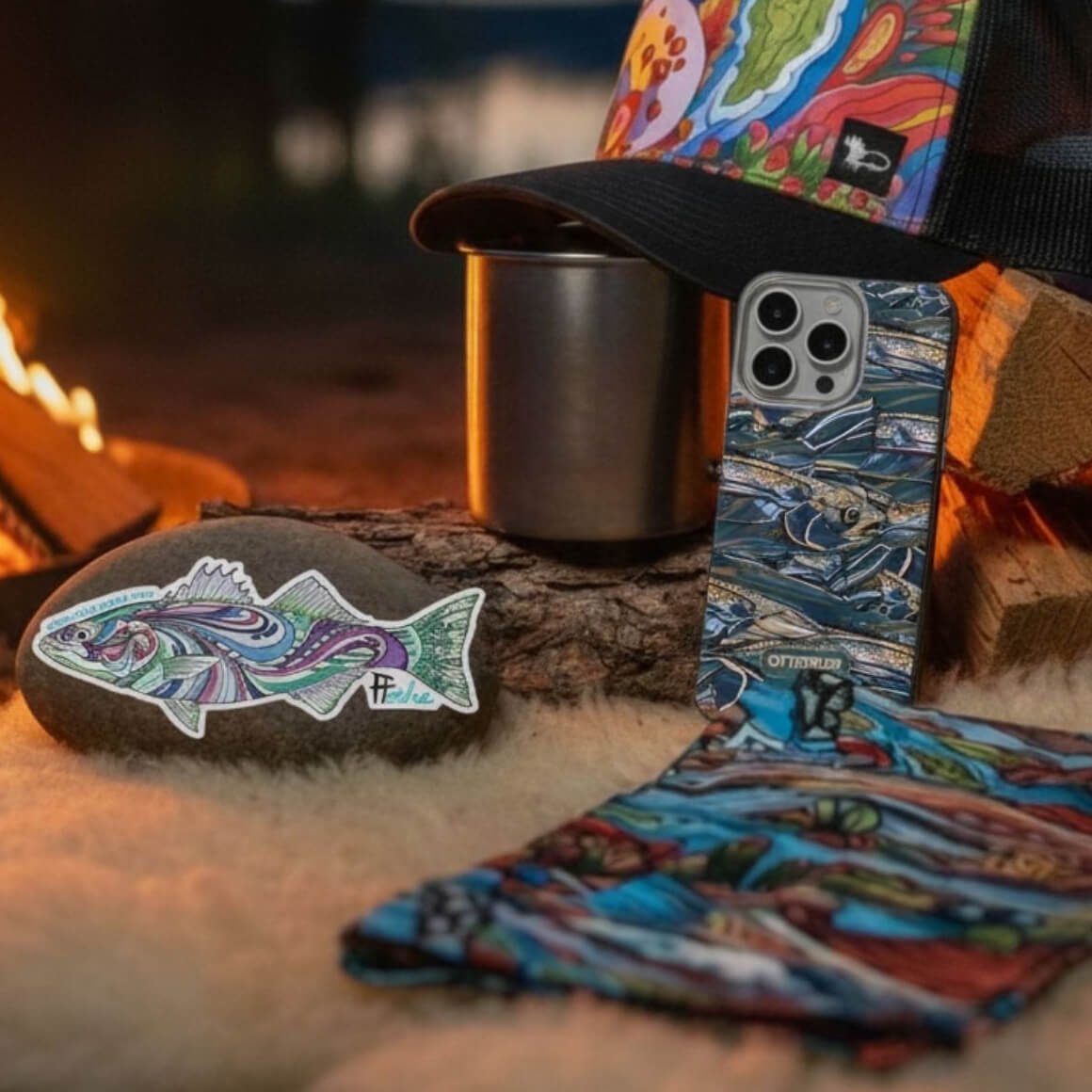

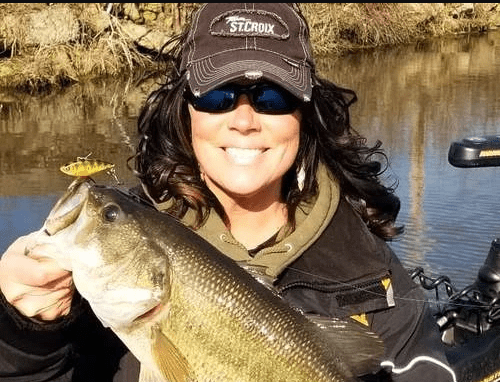
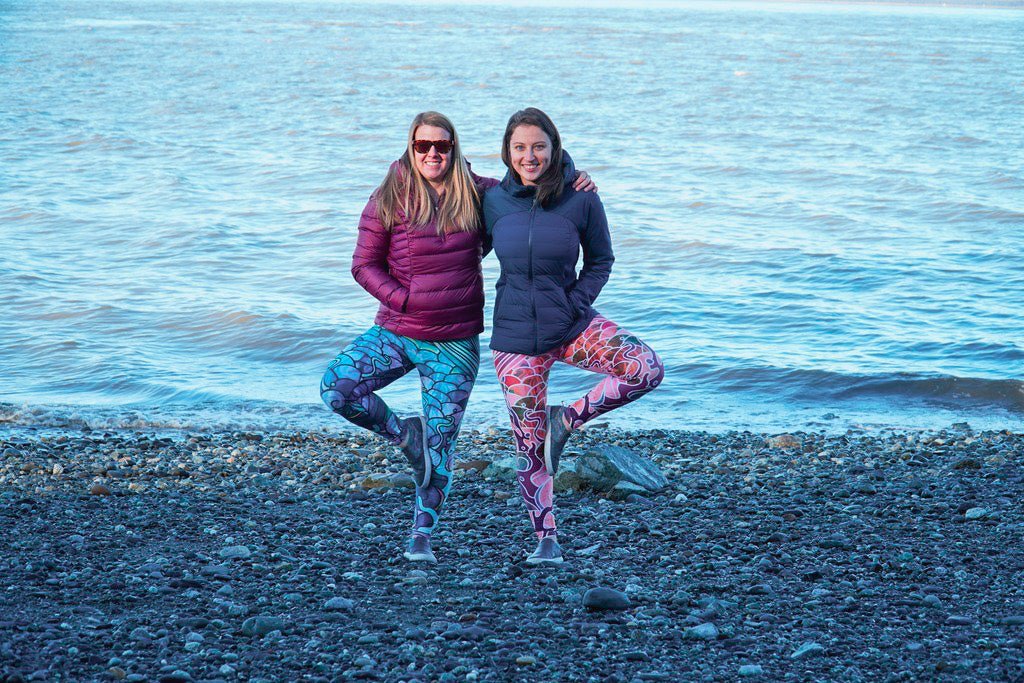


Leave a comment
This site is protected by hCaptcha and the hCaptcha Privacy Policy and Terms of Service apply.